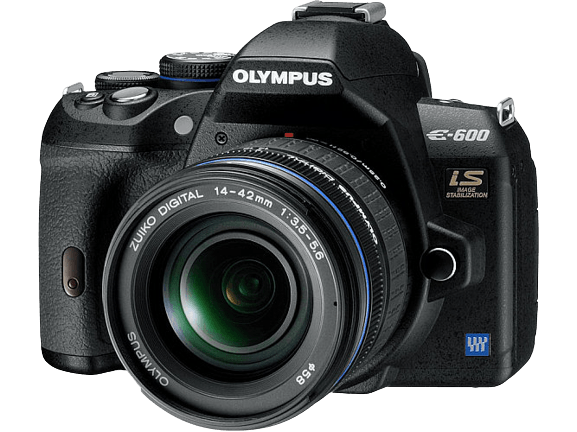Olympus E600 Specs and Scores

The Olympus E600 earns a score of 42/100 for its general specifications. Announced on August 30, 2009, this DSLR camera entered the market with a launch price of $490. Measuring 130 x 94 x 60mm and weighing 515g (1.14lbs), the E600 is compact and lightweight.
In today’s market, the Olympus E600’s specifications are modest compared to newer models. Its age and lower score reflect its position among more advanced cameras. Nonetheless, the E600 still offers a solid foundation for entry-level photography enthusiasts.
Olympus E600 Overview and Optics
The Olympus E600 receives a 43/100 score for its optics. The camera features a 12.3 megapixel Live MOS sensor, paired with a TruePic III+ processor. Its shooting speed is 4 frames per second, and it has a DXOMARK score of 55 for the sensor. The Micro Four Thirds sensor size and Micro 4/3 lens mount allow for a wide range of compatible lenses, while the built-in image stabilisation helps to reduce camera shake and improve image quality.
In today’s market, the Olympus E600’s specifications may not stand out, with other cameras offering higher megapixel counts and faster shooting speeds. The 4:3 aspect ratio is also less common, as many modern cameras opt for a 3:2 ratio. However, the E600’s optics still provide solid performance for those seeking a reliable and affordable camera.
The Olympus E600’s optics may not be groundbreaking, but they offer a dependable option for photographers who value simplicity and performance. With a wide range of compatible lenses and built-in image stabilisation, this camera remains a viable choice for a variety of situations.
Olympus E600 Video Performance
The Olympus E600, unlike many modern cameras, lacks video capabilities. This camera focuses solely on photography, without offering any video recording options. Users seeking video functionality should consider other camera models.
Olympus E600 Features and Benefits
The Olympus E600 features a score of 34/100 in the camera’s specifications. This score shows that the camera may not be on par with current market standards. The E600 has a screen size of 2.7 inches and a screen resolution of 230,000 dots. The absence of a touchscreen is noticeable, as many modern cameras now offer this functionality.
The E600 does have a flip screen, which is a useful feature for various shooting angles. However, it lacks GPS, WIFI, and Bluetooth capabilities, which are now common in today’s camera market. These missing features limit the connectivity and convenience of the E600 compared to other options available.
Taking into account the specifications of the Olympus E600, it is evident that the camera falls short in today’s competitive market. While some features, such as the flip screen, are advantageous, the lack of connectivity options and touchscreen functionality hinder the camera’s overall appeal.
Olympus E600 Storage and Battery
The Olympus E600 receives a storage and battery score of 60/100. This camera is equipped with two memory card slots, accepting both Compact Flash (Type I or II) and xD Picture Cards. Although these memory card formats were popular during the time of the camera’s release, they are less common in today’s market where SD cards are more widely used.
Regarding battery life, the Olympus E600 can capture up to 500 shots with its BLS-1 battery. This battery life is average when compared to current cameras, but the lack of USB charging might be a disadvantage for some users who prefer the convenience of charging through a USB connection.
Taking these specifications into account, the Olympus E600’s storage and battery features are decent but may not meet the expectations of users who prioritize more modern memory card formats and convenient charging options.
